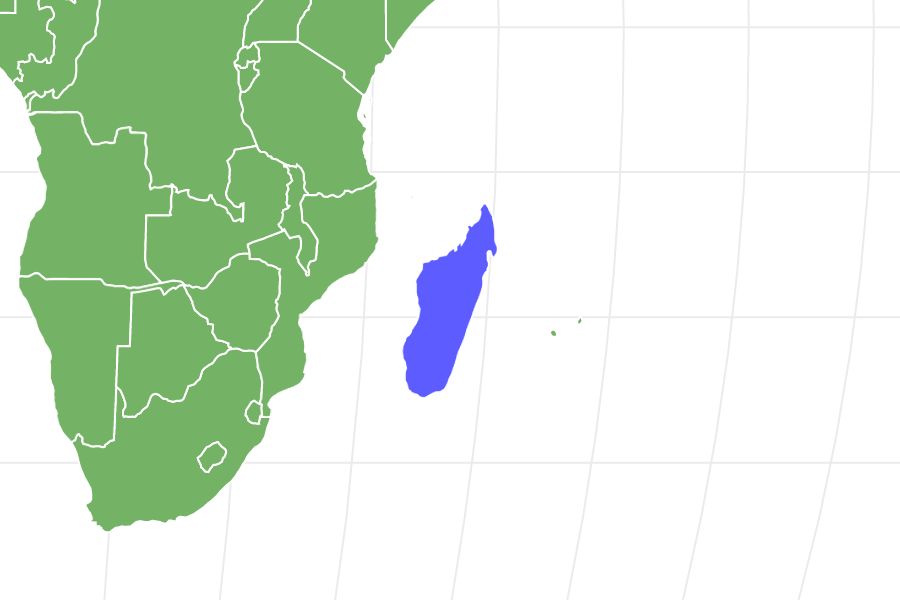Radiated Tortoise
Astrochelys radiata
The most protected tortoise in the world!
Advertisement
Radiated Tortoise Scientific Classification
- Kingdom
- Animalia
- Phylum
- Chordata
- Class
- Reptilia
- Order
- Testudines
- Family
- Testudinidae
- Genus
- Astrochelys
- Scientific Name
- Astrochelys radiata
Read our Complete Guide to Classification of Animals.
Radiated Tortoise Conservation Status
Radiated Tortoise Facts
- Prey
- Grasses, Fruits, Flowers
- Name Of Young
- Hatchling
- Group Behavior
- Solitary
- Fun Fact
- The most protected tortoise in the world!
- Estimated Population Size
- Declining
- Biggest Threat
- Habitat loss
- Distinctive Feature
- High domed protective shell and yellow limbs
- Other Name(s)
- Sokake
- Incubation Period
- 4 - 7 months
- Age Of Independence
- 1 month
- Habitat
- Dry tropical forest
- Predators
- Birds, Reptiles, Humans
- Diet
- Herbivore
- Lifestyle
- Diurnal
- Common Name
- Radiated Tortoise
- Number Of Species
- 1
- Location
- southern Madagascar
- Average Clutch Size
- 3
- Slogan
- The most protected tortoise in the world!
- Group
- Reptile
View all of the Radiated Tortoise images!
The Radiated Tortoise is a relatively large species of Tortoise, natively found on the island of Madagascar. Although having evolved in similar environments to other star-patterned Tortoises from around the tropics, the Radiated Tortoise has more striking and complex markings than those of the Indian Star Tortoise, for example. The Radiated Tortoise is also known as the Sokake in Madagascar, and although they are critically endangered in the wild, it is widely believed that they are the most beautiful of all Tortoise species. Naturally, then, they are popular exotic pets, which is thought to be one of the main reasons for their demise.

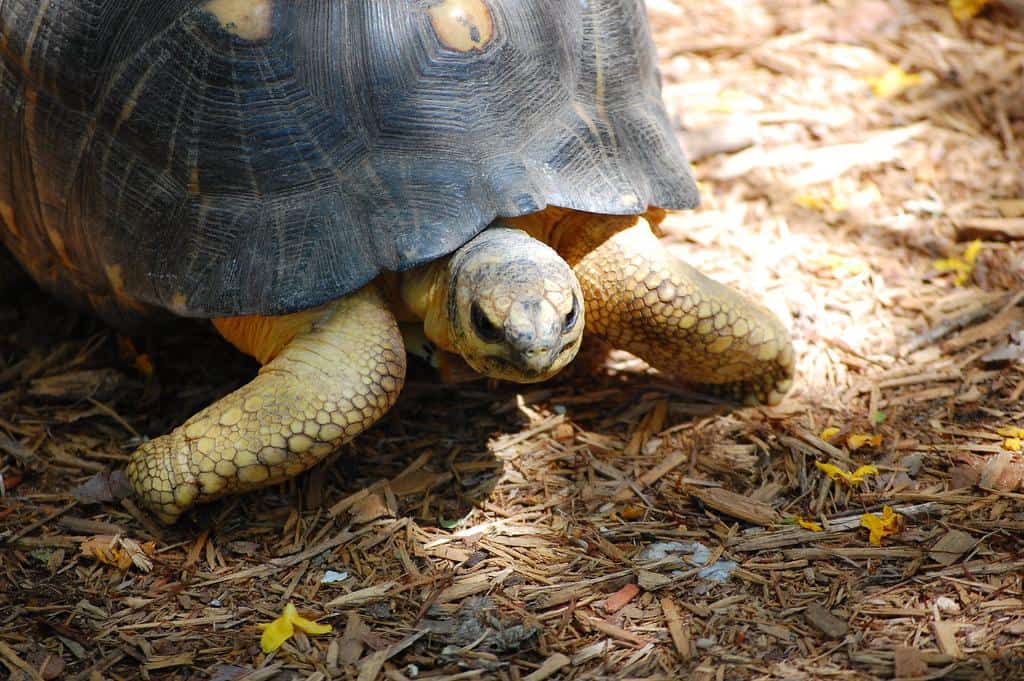
The scientific name of the Radiated Tortoise is
Astrochelys radiata.Classification
The term “tortoise” is often used interchangeably with the term “turtle,” however, the consensus is that a tortoise refers to a turtle that lives exclusively on land. They are reptiles, belonging to the class Reptilia. They are further classified into the order Testudines and the family Testudinidae. From there, there are approximately 49 species spanning more than 15 genera including Astochelys, the genera of the Radiated Tortoise. The scientific name of the Ratiated Tortoise is Astrochelys radiata.
Evolution
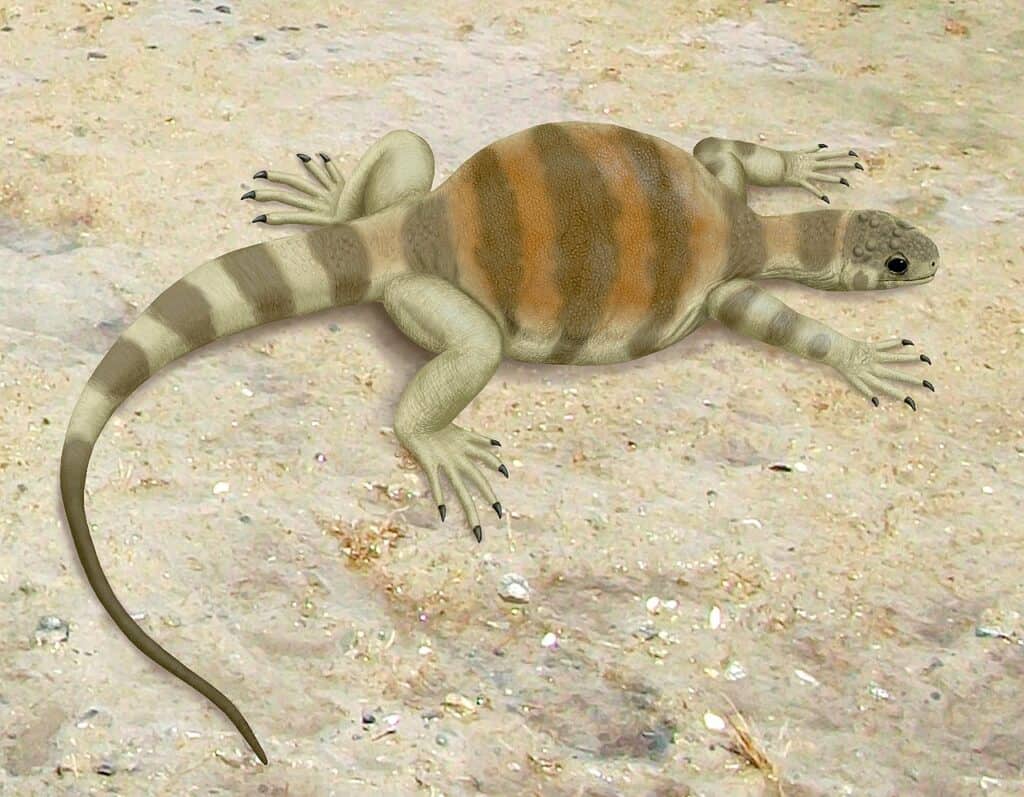
Tortoises evolved in South
Africa
, from a small reptile named
Eunotosaurus africanusaround 260 million years ago.
©Smokeybjb / CC BY-SA 3.0 – License
Tortoises and turtles evolved in South Africa, from a small reptile named Eunotosaurus africanus around 260 million years ago. This strange little lizard had the makings of modern-day tortoises with thick, backward curving ribs that formed an armored dome under its skin.
A reptile called Odontochelys semitestacea, evolved 40 million years later in the shallow oceans of China. The Odontochelys had one trait that modern turtles and tortoises share – a plastron or bottom shell. It is believed that these tortoise ancestors developed lower shells first because sharks and other predators attacked them from below the surface of the water.
Proganochelys, or “beast turtle” lived among dinosaurs and was armored above and below. In addition to its protective shell, this ancient turtle had bony neck spikes, leg spikes, and tail spikes. Like its modern relatives, it had a bony shell and a toothless mouth.
These three tortoise ancestors diverged into the terrapin, sea turtle, and tortoise we know today.
Anatomy and Appearance
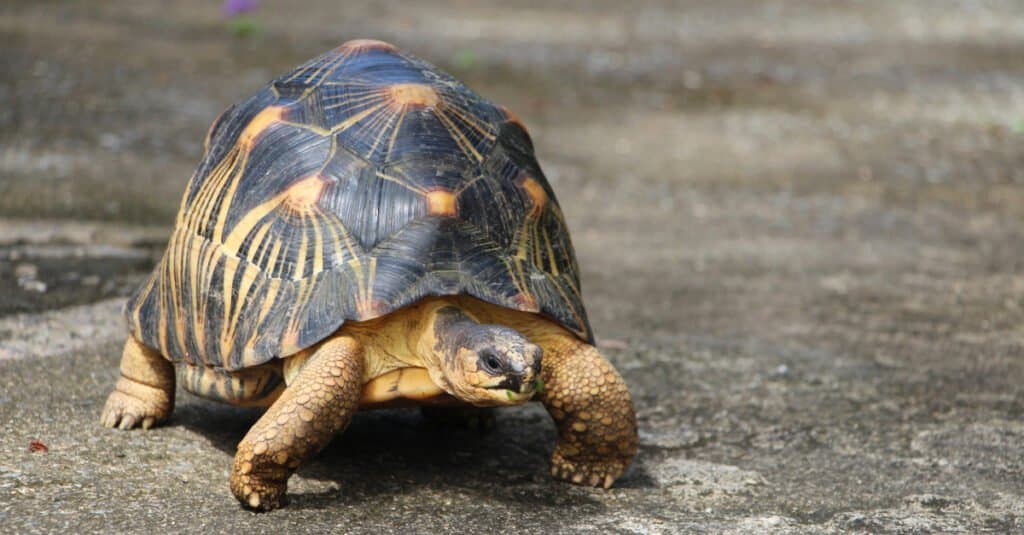
The beautiful, dome-shaped shell of the radiated tortoise never loses its unique pattern.
©seasoning_17/Shutterstock.com
The male Radiated Tortoise tends to be slightly larger than females and the two sexes are also easily identified as the tail of the male Radiated Tortoise is often substantially longer than that of the female. Radiated Tortoises have high-domed, dark brown to black shells, covered with bright yellow or orange intricate star-like patterns. Unlike other star-patterned Tortoises, the centers of the stars on the carapace of the Radiated Tortoise are not raised, giving their domed shell a smoother appearance. The legs, tail, and head are a yellowish color with a black spot on top of the head, which varies in size between individuals. The appearance of this Tortoise actually camouflages it perfectly in the long grasses.
Distribution and Habitat
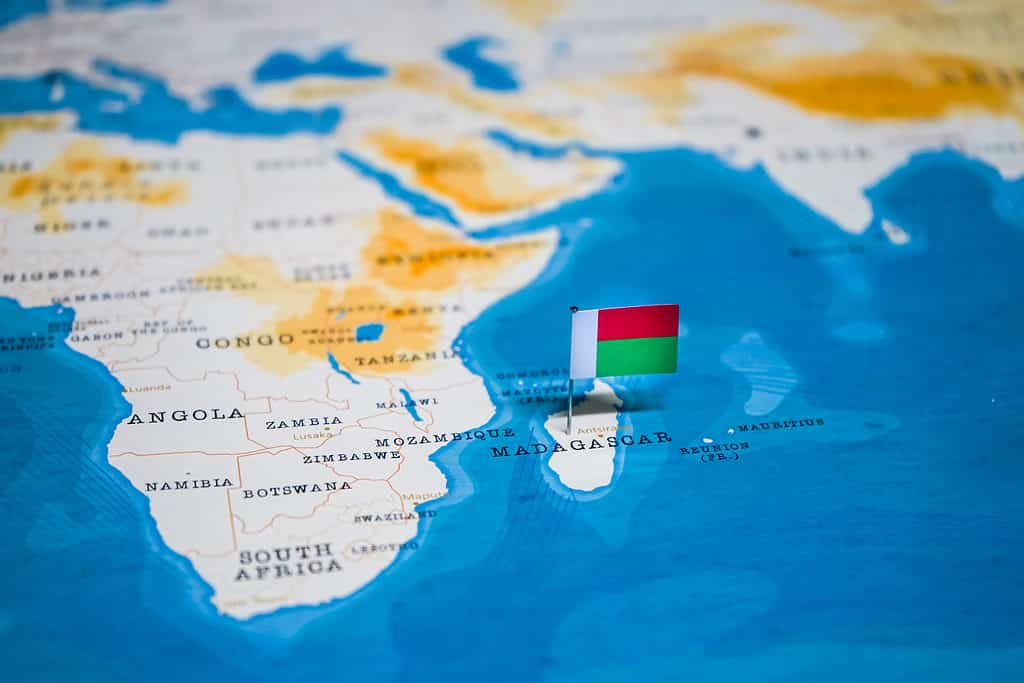
Madagascar, the home of the Radiated Tortoise, is an island off the southeast of Africa.
©Hyotographics/Shutterstock.com
The Radiated Tortoise is natively found on the island of Madagascar in the far south and southwestern parts of the island. They inhabit dry regions of brush, thorn forests, tall grasses, and woodland, with the whole population found in an area of 10,000 km squared. Isolated populations can still be found on the higher plateaus as well, but these habitats are incredibly fragmented and the existence of the Tortoise here is not thought to go on for much longer. The Radiated Tortoise is thought to have disappeared entirely from around 40% of its historical range, due to both habitat loss and exploitation.
Behavior and Lifestyle
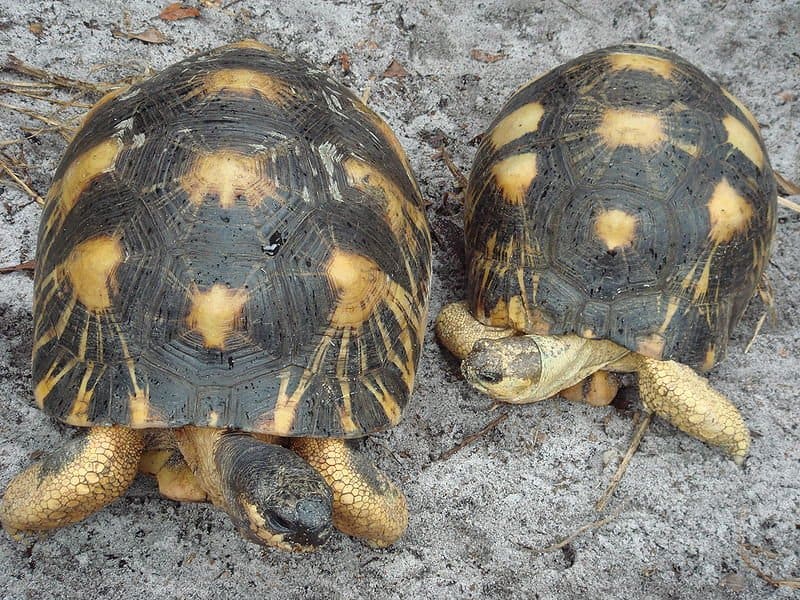
Radiated tortoises are solitary except during mating season.
Like many other Tortoise species found around the world, the Radiated Tortoise generally leads a fairly solitary life, although it is not uncommon for a number to be found grazing together (particularly around the breeding season). They are incredibly adaptable to the changing seasons from dry and arid to the heavy rains of the monsoon, when they are said to almost dance in the rain to shake it off. Radiated Tortoises also emit a loud screeching sound when startled to hopefully intimidate and then scare off the unwelcome predator. The Radiated Tortoise is a peaceful animal but will become aggressive towards individuals that it sees as a threat.
Reproduction and Life Cycles

Female Radiated Tortoises lay 5 – 10 eggs in a nest that she digs in the ground.
©Attila N/Shutterstock.com
Radiated Tortoises usually begin mating when they are around half their adult size, and it starts with the male bobbing his head up and down to court his female. Once mated, the female digs a nest in the ground where she lays up to 5 small eggs (although 10 or more is not uncommon). After an incubation period of between 4 and 7 months, the young Radiated Tortoises hatch measuring between 3 and 4 cm. Although they are born with their detailed star patterns, the markings are white until they grow older. Radiated Tortoises usually live for 40 to 50 years, but some have been known to be more than 100.
Diet and Prey
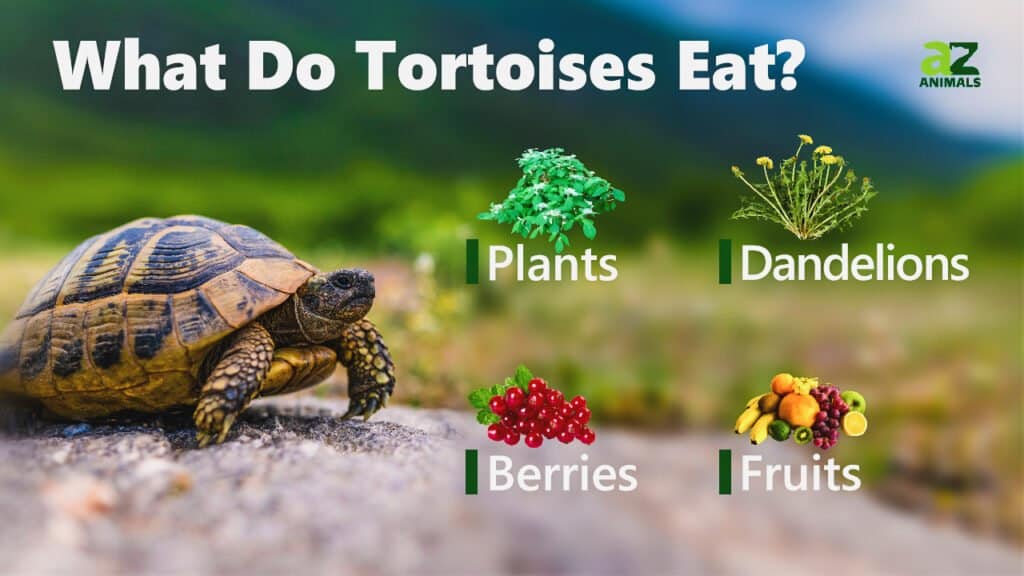
The Radiated Tortoise is a primarily herbivorous animal, and although the majority of its diet is comprised of plant matter, they are known to supplement its nutrition by eating a small animal every now and again. Despite this, they need a high-fiber and low-protein diet to survive the most successfully. Leafy greens, grasses, and herbs make up the bulk of the Radiated Tortoise’s food, along with other plant matter like fruits, berries, and prickly pears. In a book written about Tortoises from around the world, the Radiated Tortoise is said to be particularly partial to eating foods that are red in color.
Predators and Threats
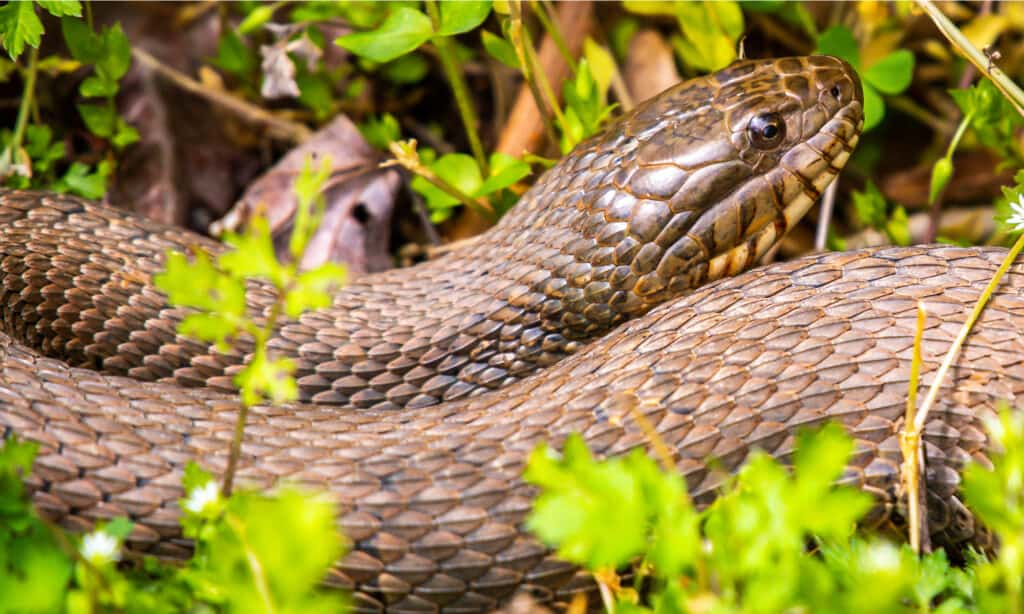
Kingsnakes are known to prey on tortoises on a regular basis.
©Krumpelman Photography/Shutterstock.com
In their natural habitats, these ground-dwelling animals are prey to a number of predators including Snakes and large Birds Of Prey. Radiated Tortoises have a couple of defense mechanisms to try to protect them seeing that they can’t run away, including making a loud screeching sound and the ability to pull their soft limbs and head inside their hard shells. Humans are, however, the biggest threat to the Radiated Tortoise both through habitat destruction and exploitation. The Radiated Tortoise is commonly consumed and captured for the exotic pet trade.
Interesting Facts and Features

A Radiated Tortoise named Tu’i Malila was given to the British royal family in the mid-1700s and lived 250 years.
The oldest living reptile was a Radiated Tortoise known as Tu’i Malila which was given to the Royal family in the mid-1700s by explorer Captain James Cook, and she died in 1965 at around 250 years old from natural causes. Although Radiated Tortoises are native to Madagascar, they have been introduced to the islands of Reunion and Mauritius in the Indian Ocean to boost their Tortoise populations. Despite the fact that many Radiated Tortoises are eaten in Madagascar, it is actually people coming from other parts of the island, as the local tribes living alongside Radiated Tortoises believe there is a taboo against both touching and eating them.
Relationship with Humans
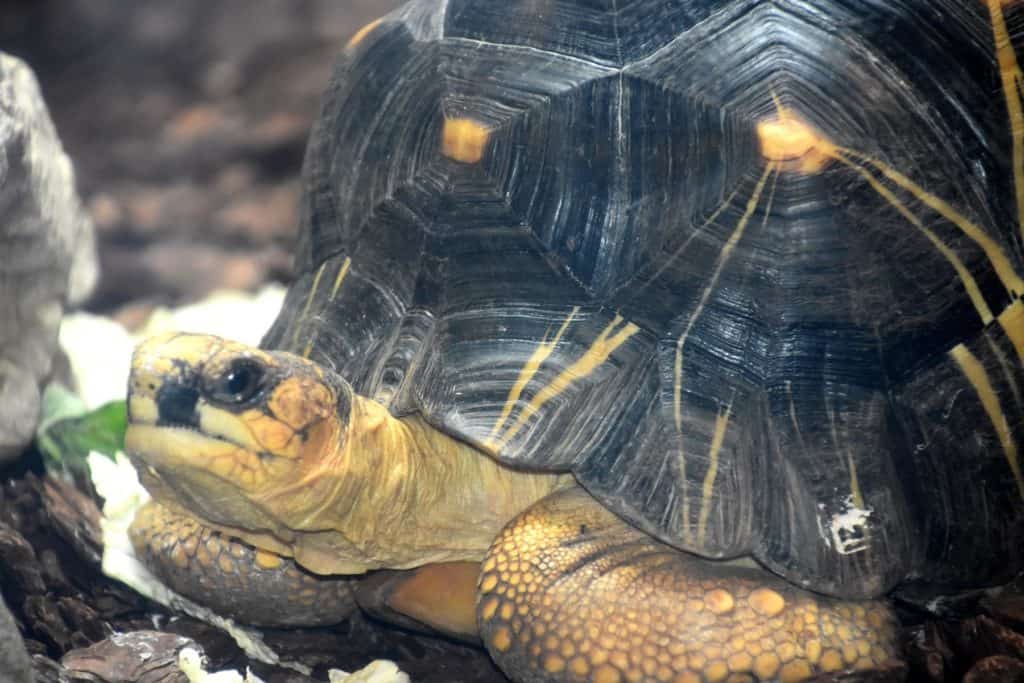
Humans are the biggest threat to the Radiated Tortoise – 45,000 are killed each year for food.
©Millie Bond – Copyright A-Z Animals
Humans are the biggest threat to Radiated Tortoises, from habitat destruction to their consumption. It is thought that the remaining populations have seen an 80% reduction in numbers over just three generations and those inhabiting south Madagascar’s higher plateaus are even worse affected. Despite the fact that the Radiated Tortoise is now one of the most protected Tortoise species in the world, an estimated 45,000 are killed every year across the southern part of the island, just for food. The beauty of the Radiated Tortoise has also meant that they are in high demand in the illegal exotic pet trade.
Conservation Status and Life Today

The Radiated Tortoise has been listed as being Critically Endangered.
Due to a dramatic fall in population numbers, the Radiated Tortoise has been listed as being Critically Endangered and is therefore under severe threat of becoming extinct in the wild forever. However, captive breeding programs have been relatively successful and are crucial to the survival of this species in the future. Due to the laws about exporting listed species though, there are few found in captivity, most of which are in the USA where they were taken before the species was declared to be at imminent risk of extinction.
View all 114 animals that start with RRadiated Tortoise FAQs (Frequently Asked Questions)
Are Radiated Tortoises herbivores, carnivores, or omnivores?
Radiated Tortoises are Herbivores, meaning they eat plants.
What Kingdom do Radiated Tortoises belong to?
Radiated Tortoises belong to the Kingdom Animalia.
What phylum to Radiated Tortoises belong to?
Radiated Tortoises belong to the phylum Chordata.
What family do Radiated Tortoises belong to?
Radiated Tortoises belong to the family Testudinidae.
What order do Radiated Tortoises belong to?
Radiated Tortoises belong to the order Testudines.
What type of covering do Radiated Tortoises have?
Radiated Tortoises are covered in Scales.
What genus do Radiated Tortoises belong to?
Radiated Tortoises belong to the genus Astrochelys.
Where do Radiated Tortoises live?
Radiated Tortoises live in southern Madagascar.
In what type of habitat do Radiated Tortoises live?
Radiated Tortoises live in dry tropical forest.
What are some predators of Radiated Tortoises?
Predators of Radiated Tortoises include birds, reptiles, and humans.
What are some distinguishing features of Radiated Tortoises?
Radiated Tortoises have high domed protective shells and yellow limbs.
How many eggs do Radiated Tortoises lay?
Radiated Tortoises typically lay 3 eggs.
What is an interesting fact about Radiated Tortoises?
Radiated Tortoises are the most protected tortoise in the world!
What is the scientific name for the Radiated Tortoise?
The scientific name for the Radiated Tortoise is Astrochelys radiata.
What is the lifespan of a Radiated Tortoise?
Radiated Tortoises can live for 30 to 80 years.
How many species of Radiated Tortoise are there?
There is 1 species of Radiated Tortoise.
What is the biggest threat to the Radiated Tortoise?
The biggest threat to the Radiated Tortoise is habitat loss.
What is another name for the Radiated Tortoise?
The Radiated Tortoise is also called the sokake.
How fast is a Radiated Tortoise?
A Radiated Tortoise can travel at speeds of up to 0.3 miles per hour.
How to say Radiated Tortoise in ...
Thank you for reading! Have some feedback for us? Contact the AZ Animals editorial team.
Sources
- David Burnie, Dorling Kindersley (2011) Animal, The Definitive Visual Guide To The World's Wildlife
- Tom Jackson, Lorenz Books (2007) The World Encyclopedia Of Animals
- David Burnie, Kingfisher (2011) The Kingfisher Animal Encyclopedia
- Richard Mackay, University of California Press (2009) The Atlas Of Endangered Species
- David Burnie, Dorling Kindersley (2008) Illustrated Encyclopedia Of Animals
- Dorling Kindersley (2006) Dorling Kindersley Encyclopedia Of Animals
- Radiated Tortoise Facts, Available here: http://nationalzoo.si.edu/Animals/ReptilesAmphibians/Facts/FactSheets/Radiatedtortoise.cfm
- Radiated Tortoise Care, Available here: http://www.chelonia.org/articles/Gradiatacare.htm
- Radiated Tortoise Details, Available here: http://www.iucnredlist.org/apps/redlist/details/9014/0
- Radiated Tortoise Behaviour, Available here: http://www.petinfospot.com/985/tortoise/radiated_tortoise.html
- About Radiated Tortoises, Available here: http://www.unc.edu/~dtkirkpa/stuff/radiated.html

